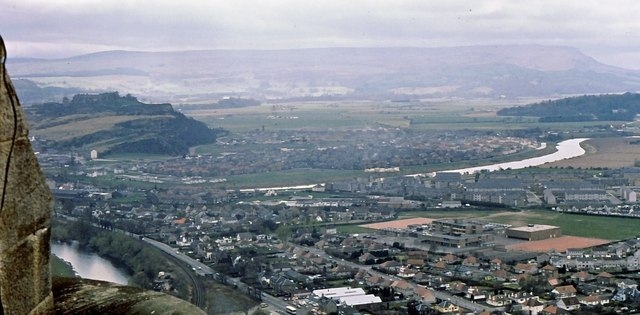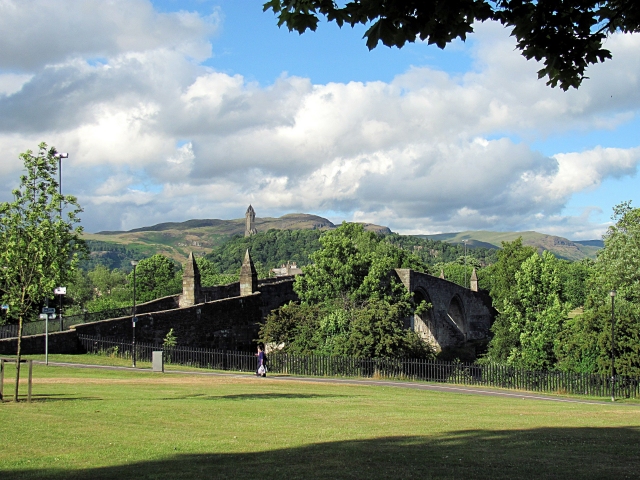
The stairs are dark, narrow and winding. I don't know why I didn't realize this would be a spiral staircase. The steps are high for my short little legs and I keep my eyes on Robin's feet. I want her in front of me as a challenge for me to keep up.
I've been sitting lazily in the car much of the past twenty-four hours. No Walltown Crags to conquer the day before, no hills to climb other than the gentle hill at Castlerigg and then a long ride this morning. I need motivation to keep me moving ever upward.
"Don't worry," Robin says over her shoulder, as if reading my mind. "There are resting spots." We take advantage of these landings, which appear every seventy-five steps or so. Each one features a small exhibit – swords, a William Wallace hologram (which, thankfully, looks nothing like Mel Gibson) disavowing the charges made against him by a rather young looking Longshanks who is projected upon the walls, statues, and stained glass. The breaks are welcome but I feel a strength building in me, a sense of pride and a need to continue climbing.
Up the narrow staircase we climb, pressing ourselves to the walls, making ourselves as small as possible as other visitors make their way back down. Finally, we reach the top. I step out of the dark stairwell, peer out over the retaining wall, and watch the world spin. Off my glasses go and with my back to safe, solid stone wall I look out on the many twists and turns of the Forth.
This is where it happened. Having read and studied the movements that both sides made in this decisive battle, I can see it all now – hear the shrieking cacophony, the wild skirl of pipes and the screams of the horses as they collided with the initial onslaught of Scots' spears. I can see thousands more Scots come pouring forth from the thicket along the base of the crag on which I stand – see them charging across the boggy ground barefoot, raising a high keen cry, see scores of the English drowned in the rising waters of the Forth as they attempted to flee the slaughter.
This is where it happened. In this place, over seven hundred years ago, a man became a national hero and symbol for a nation, an international symbol of patriotism. This is where rebellious nature, cunning, courage and intelligence superseded the tyrannical reign of a wily overlord. But I digress ... or expound ... or something.
It's much easier going down than it was going up, although my glasses remain in my hand rather than on my face, so it's just as slow. We collect Dana from the bench and head into the gift shop. I reward myself for making it to the top with a small bottle of Wallace Single Malt scotch whisky and a few trinkets for my children.
I shake my head at the "I Climbed the Wallace Monument" tee-shirts and post cards and head for a rack of clan postcards. These postcards are oversized cards of clan tartan with the clan motto and crest pictured. I pick up a Buchanan card for a friend and spin the rack, looking for and finally finding Wallace. Of the hundred or so clan post cards here, Wallace is the only one that has a picture from the movie "Braveheart" where the clan crest should be. I shake my head, disappointed again at the blatant tie-in to Mr. Gibson's Hollywood vision.
The shuttle is waiting just outside of the gift shop and returns us to the car park at the bottom of the hill.

The Battle of Stirling Bridge was a battle of the First War of Scottish Independence. On 11 September 1297, the forces of Andrew Murray and William Wallace defeated the combined English forces of John de Warenne, 6th Earl of Surrey, and Hugh de Cressingham near Stirling, on the River Forth.
The small bridge was broad enough to let only two horsemen cross abreast, but offered the safest river crossing, as the Forth widened to the east and the marshland of Flanders Moss lay to the west.
The Scots waited as the English knights and infantry made their slow progress across the bridge on the morning of 11 September. It would have taken several hours for the entire English army to cross.
Wallace and Murray waited until "as many of the enemy had come over as they believed they could overcome". When a substantial number of the troops had crossed, the attack was ordered.
Read more about the Battle of Stirling Bridge at Wikipedia.